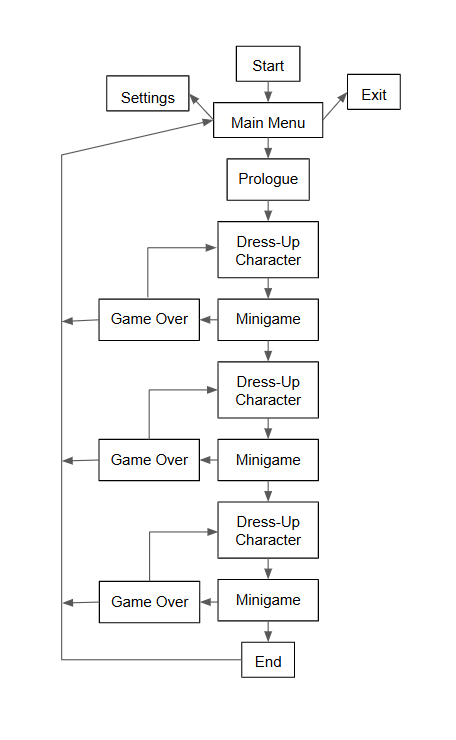Game Flowchart

The game flow itself is simple and repetitive (story –> dress-up –> minigame). The gameplay starts in Genevieve’s dressing room. During the story segments, she can interact with other characters and items before getting dressed for an event (following a theme) and entering the minigame level.
Core Gameplay
The core gameplay in Genevieve will be doing her makeup and dressing her up. Rhythm/QTE minigames and communicating with NPCs will break up regular gameplay. These will all serve to progress the game.
Dress up
- The look and feel of dressing up the main character will be based on classic flash dress-up games. The main inspiration comes from 2000s Barbie and Myscene browser games such as Barbie Makeover Studio, Myscene: Shopping Spree, and the old Barbie website (See the World Design page for moodboards and art). To incorporate the dress-up segment into the narrative, the player will be given a theme and the objective will be to dress Genevieve appropriately for the venue/event. The player will be given clues through character dialogue and the environment on which outfits will work and which won’t. After saving the outfit and makeup, they’ll exit the dressing room and be taken to another level where the character’s appearance will then be scored and added to the score at the end of the minigame.

Minigames
- Rhythm Minigames – After dressing up the main character, the player leaves the dressing room and enters the stage/photoshoot set, pressing a button/prompt and starting the minigame. The player must press the corresponding buttons to the beat of a song. Get too many wrong and the minigame ends, giving the player the option to retry as well as change the outfit to get a better score or continue.
- Quick Time Events – Later in the game, especially when Genevieve needs to stay calm, QTEs will be used to keep her hallucinations at bay and her sanity at equilibrium. Having this mechanic heightens the sense of panic.
Communicating with NPCs
- Dialogue choices with other characters can lead to branching options and alter the story through short-term and long-term consequences. For example, if another character has offered a helping hand, choosing to respond passive-aggressively as opposed to politely will negatively affect the relationship with that character. Branching options allow players to learn more about a character and possibly use the information later. For example, if a character opens up and confides in Genevieve, the player may be able to use this against them later in the game.
Reply